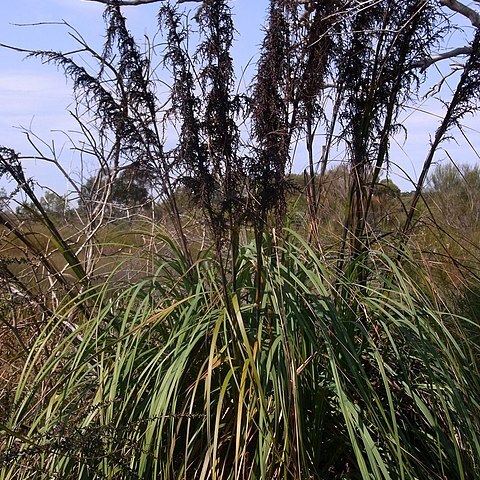Stems 1-3 m by 5-10 mm. Leaves as long as the stems, broadened at the base, with scabrous involute margins; sheaths dark brown. Inflorescence decompound, up to 90 by 4-8 cm, rather dense, erect, consisting of numerous fascicles of partial panicles, the lower fascicles distant; primary branches up to 4 together, rigid, with scabrous margins; branchlets 2-4 together, often arcuately recurved. Bracts as long as or longer than the inflorescence; sheaths brown at the base. Spikelets oblong, finally subclavate, in clusters of 2-4, 5-6 mm long, shortly peduncled, 2-flowered. Glumes 5-7, the lower 3-5 empty, mucronulate, the upper 2-3 smaller. Stamens 3-4 in each flower; filaments scarcely elongated after anthesis, finally 3-4 mm long, their apices coherent. Nut ellipsoid, 3-4 by 1½-2 mm, sub-tetragonous, shortly acuminate, smooth, densely puncticulate, shining brown or red. Endocarp sulcate (with 5-6 grooves). Cleaving-mechanism.
More
A sedge or herb. It forms clumps and keeps growing from year to year. The stalks are 3 m long. They are slender. The leaves are 2 m long by 2 cm wide. They are flattened but often rolled and rough and have a channel on the upper surface. The flowering stalks are 60 cm long. The branches spread. There is a bract near each branch. The flower stalks are pale brown. There are many small spikelets. The flowers are cream. The nut is about 0.4 cm across. They are red-brown and shiny.
It is a temperate plant. It also grows in the tropics. It grows in a range of places and in different soils. The soils should be moist. It can withstand dry periods, once established. It can tolerate heavy shade and grow in full sun. It is hardy to frost and can tolerate waterlogging. It suits hardiness zones 8-9. Tasmanian Herbarium.
More
Forming large clumps in swamps, moist localities in savannah-forests, on sandy soil in Vaccinium-scrubs, and in Dacrydium-forests; 300-2600 m.

